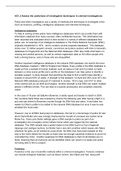AC1.2 Assess the usefulness of investigative techniques in criminal investigations
Police and other investigators use a variety of methods and techniques to investigate crime.
Such as forensics, profiling, intelligence databases and interview techniques.
Intelligence databases
To help in solving crimes police have intelligence databases which can provide them with
information obtained from many sources, often confidential sources. This information has
been recorded and evaluated which is then stored in a variety of different databases that
police use. An example of an intelligence database is The Police National Computer (PNC),
originally established in 1974, which contains several separate databases. This database
stores over 12 million people’s arrests, convictions and police cautions with links to biometric
databases for fingerprints and the National DNA databases. PNC also holds information on
missing and wanted persons, as well as vehicle registration data on 48 million people who
hold a driving licence, and on those who are disqualified.
Another important intelligence database is the national DNA database, the world's first ever
DNA database created in 1995 for England and Wales. Every profile in the DNA database is
made up from a sample of human material, such as saliva or hair and if a match is made
between a crime scene profile and a profile on the database it can help police to identify a
possible suspect. A study showed that searching the data to find a match helps identify a
suspect in around 60% of cases. A strength is that between 1st April and 30th June 2013 the
National DNA database produced 37 matched to murder, 103 to rape, and 6141 to other
crime scenes sich as car theft and burglary. Another strength is that DNA can match multiple
pieces in different crimes. This can lead to a quicker prosecution and complete unsolved
cases.
In the case of 18 year old SallyAnn Bowman, brutally raped and beaten to death in 2005.
Her murderer Mark Dixie was arrested by chance the following year after having a fight in a
pub and was linked to Bowmans murder though his DNA that was taken. It has taken two
weeks for Dixie's profile to be added to the national DNA database but once it was he was
arrested five hours later.
However, due to all DNA being kept on databases, this led to a miscarriage of justice for taxi
driver David Butler who was wrongly imprisoned for murder of Liverpool sex worker Anne
Marie Foy. Years prior Butler willingly gave a DNA sample to police as part of an
investigation into a burglary at his mothers home which was logged into the national
database. This DNA sample was a partial match to the DNA found on Foy’s fingernail
clippings and cardigan buttons, but Butler had a rare skin condition which leaves skin flakes
wherever he goes, as he worked as a taxi driver, his DNA may have been passed on this
way to the victim before the murder so there was not enough sutantical evidence to prove he
committed the crime. Another weakness for DNA databases is that not all families are on
there, meaning that not everyone can be identified which can result in no leads and police
not being able to find a suspect.
Forensics
Forensics is the use of scientific methods within a criminal investigation. Forensic evidence
can include biological materials, such as blood, semen, skin flakes and hair, along with





